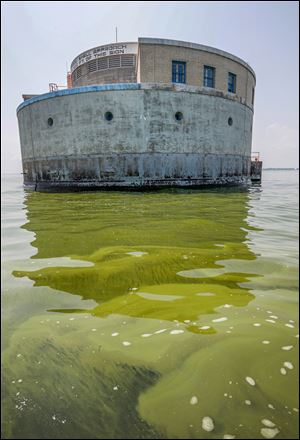
Media covering each wave of crisis
Toledo-area ban on drinking water draws national spotlight
8/4/2014
Algae is visible in Lake Erie near the Toledo water intake crib, Sunday.
Toledo has, once again, been thrust into the national spotlight, this time because of a toxic algae bloom that prompted a ban on drinking water.
The ban, which was first reported by city officials at about 2 a.m. Saturday, sent local media into a dizzying frenzy of wall-to-wall coverage that surpassed any other major breaking-news story in recent memory.
“The only thing that compares is the tragedy of tornado outbreaks a few years ago, and even this has eclipsed that,” said Brian Trauring, the news director of WTVG-TV, Channel 13, The Blade’s news partner.
PHOTO GALLERIES:
■ Kasich, Collins comment as Toledo water crisis continues
■ Toledoans still scurrying for water supplies
■ Algae at Toledo water intake crib
Toledo’s two largest news stations, WTVG-TV and WTOL-TV, Channel 11, ran hours of nonstop coverage on television starting at 6 a.m. Saturday. Channel 13 didn’t stop live broadcasts until 11:30 p.m. Channel 11 briefly went off coverage, but was back up at 6:30 a.m. and ran until 11 p.m., said news director C.J. Hoyt.
Nonstop coverage “ends up being determined by the story itself, how serious of an issue it is for our viewers,” Mr. Hoyt said. “With more than 400,000 people affected at one time, it was a pretty easy decision.”
Mr. Hoyt said anchor Melissa Andrews likely broke a record, at least at their station, on Saturday after she anchored for 14 straight hours.
All stations, including WNWO-TV, Channel 24, called in staffers to help provide that constant coverage, which spread to Web sites and across social media platforms.
Jim Blue, an anchor at WNWO, was on his way back to Toledo from Chicago on Sunday afternoon. He was scheduled for a vacation.
News director Nicole Hahn said WNWO did live cut-ins to programs whenever new information was available, but opted to not do continuous live-streaming coverage. Ms. Hahn said the station, between live takes, focused on its Web site and social media.
Photos from Blade photographers ran in newspapers across the country; stories produced by Blade reporters appeared in newspapers across the state. The Blade’s Web site, toledoblade.com, was updated dozens of times Saturday and Sunday by a team of reporters and editors called into action. Reporters kept thousands of followers on Twitter informed about breaking developments.
Scott Sands, program director at 1370 WSPD said he went live on the radio station at about 3 a.m., and remained so until other staffers came in. The station stayed live until about 7 p.m., sharing updates and taking calls from people across the region who provided information about where others could find bottled water.
While local news agencies were on the ground, on television, and taking over radio waves, the story spread to major news outlets such as ABC, which had reporters in Toledo, and CNN, the New York Times, Wall Street Journal, Chicago Tribune, and the Los Angeles Times.
Many national, regional, and state newspapers used coverage provided by The Blade.
Detroit news agencies were looking for local angles because the water ban affected some areas of southeast Michigan as well.
Contact Taylor Dungjen at tdungjen@theblade.com, or 419-724-6054, or on Twitter @taylordungjen.